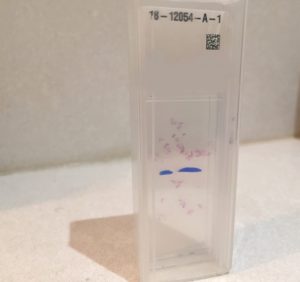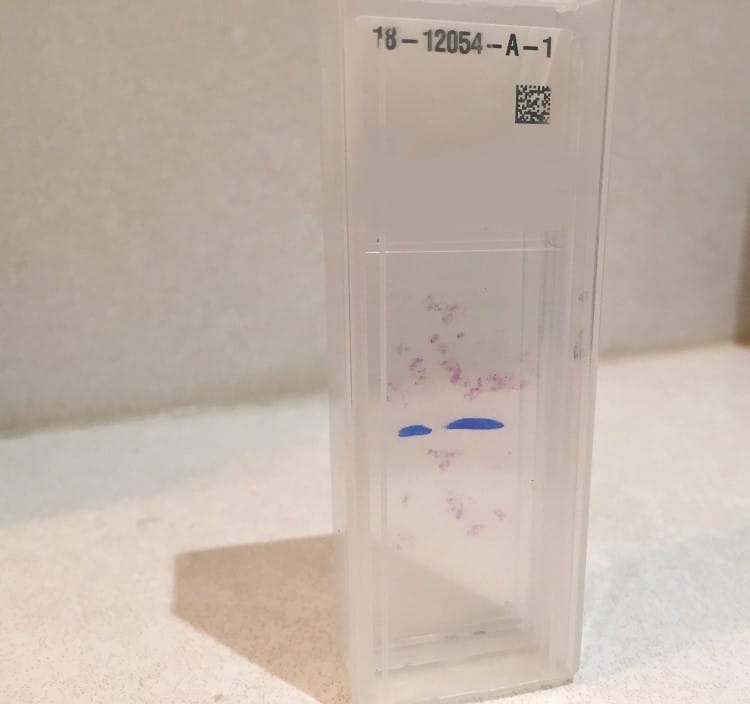Last Updated on October 31, 2024 by Ellen
The only reason I knew about my small, invasive breast cancer tumor is because I had a solid understanding of my non-invasive “DCIS” diagnosis. Based on that understanding, I opted for a bilateral mastectomy. The invasive tumor wasn’t found until the post-surgery biopsy.
Initially I was diagnosed with early stage breast cancer, the type called DCIS, which stands for ductal carcinoma in situ. Experts call this Stage 0 breast cancer. Some people call it “pre-cancer” — but I think that term is dangerous.
DCIS is non-invasive cancer, and that confuses people, but it’s still cancer. But if it’s not invasive, how can it be cancer?
Do not be confused — DCIS *is* cancer
I read an analogy about DCIS that sticks with me. It’s by a science writer who has a doctorate in genetics. She is not your average medical reporter adding to the confusion in mainstream media about using “active surveillance” on this cancer.
She herself had DCIS. She put it this way:
If Hannibal Lecter from The Silence of the Lambs is in prison, he can’t eat people. However, just because he’s contained does not change what he is. If Lecter got out of jail, he would again eat people.
DCIS is like Lecter.
If DCIS is trapped inside a milk duct, it can’t kill outside breast tissue. However, just because it is contained does not change what it is. If DCIS got of jail, the cancer would kill more cells and spread.
So how long until this non-invasive cancer breaks out of jail and goes cannibal? That’s the gazillion-dollar question, and this is where more people get even more confused.
Low-grade vs. high-grade
Which DCIS cases become invasive, and when, are mysteries. Sometimes it never happens, sometimes it takes years, sometimes months. Because doctors don’t know, cases were treated the same in years past. But today, scientists know some DCIS cases are more risky.
Medical researchers say risk factors can increase the chance of DCIS becoming invasive: age, ethnicity, hormone status, size of affected area, high-grade status and necrosis, and family history.
The only way to determine the grade of DCIS is through a biopsy and its pathology report.
If someone is diagnosed with low-grade DCIS (grade 1), the bad cells aren’t growing very fast. Scientists believe it might take five years or longer for low-grade DCIS to break out of jail — if it ever does.
Women with low-grade DCIS sometimes opt to wait and see what happens. They monitor any growth through regular check ups. This is the “active surveillance” approach often talked about in mainstream media reports.
Experts believe intermediate-grade DCIS (grade 2) also is more likely to become invasive after five years – but it is possible it could happen sooner. Many women with this diagnosis also decide on active surveillance.
High-grade DCIS (grade 3) is a different story. I have never read of any doctor with the opinion that a woman should use active surveillance for grade 3 DCIS. And I have read a lot of medical studies and journals — I do not rely on mainstream media reports.
High-grade DCIS is more likely to become invasive cancer at any point from the time of diagnosis to within five years. This stuff grows fast. It kills a lot of cells within that milk duct jail. Those dead cells pile up in the duct. That is called necrosis. It is common with high-grade DCIS.
The main treatment for high-grade DCIS is the removal of affected tissue by either lumpectomy (removal of part of the breast) or mastectomy (removal of the breast). The idea is to get it out of there before it becomes invasive in breast tissue outside the duct – and in the body outside the breast.

Upstaging
Once all of the high-grade DCIS is removed, it’s biopsied. Sometimes the final pathology report will discover micro-invasion. That’s when the cancer has just started to grow on the outside of the milk duct.
Sometimes pathologists discover an invasive cancer tumor (or two or three) where none was previously seen.
That’s what happened to me.
My one small, invasive tumor was right next to my high-grade DCIS.
Was the tumor the result of my high-grade DCIS? No one can definitively say. But — the hormone receptors on the tumor were identical to the hormones in the DCIS.
My initial diagnosis was Stage 0 – non-invasive early breast cancer, with high-grade DCIS. There was a lot of it, and so the chances of my cancer breaking out of jail were even higher. I decided to have a bilateral mastectomy.
When pathologists examined all of the tissue, they found a tumor previously unseen near the DCIS. I was upstaged to Stage 1 – invasive early breast cancer – from Stage 0 – non-invasive early breast cancer.
Many studies say 27 to 33 percent of high-grade DCIS cases will be upstaged from non-invasive to invasive. I happened to be one such case.
Also, my type of tumor happened to be one of the most aggressive – but it was caught extremely early. Good thing I didn’t try active surveillance. With or without adjuvant therapies, my chances for survival with no recurrence within five years are high.
Sources that only add to the confusion
During my research, I came across an article on DCIS treatment written by a doctor and officer with the American Cancer Society. The doctor’s post is on the Society’s official website. I couldn’t believe it — he did not distinguish between grades, and how that might affect treatment!
Imagine a woman scared out of her mind, trying to find information about her (high-grade) DCIS. Now imagine she finds this doctor’s article on the American Cancer Society’s website, which suggests more active surveillance is needed on DCIS — and the article doesn’t differentiate between grades.
Wow! See what I mean about confusion? (I alerted the web staff, but it hasn’t been changed.)
Adding to the confusion: women who run blogs about ‘holistic approaches’ or ‘active surveillance’ or ‘natural remedies’ for DCIS. Some of these blogs are quite popular.
But these women generally fail to distinguish between high-grade and low-grade DCIS on their ‘support’ articles.
Am I saying a woman with a small area of grade 1, low-grade, lower-risk DCIS should have a double mastectomy next week? Of course not! Am I saying every woman with high-grade DCIS will have invasive cancer hidden in the area? Of course not!
But for someone like me who is high risk, my grade 3 DCIS filled up that milk duct jail pretty fast – I got checked every year.
It seems to me those early breast cancer cells could have easily pushed Hannibal Lecter out of that milk duct prison to become invasive cancer, and kill.
If you landed here and have triple positive breast cancer, with a tiny tumor, you are like me – someone with a rare diagnosis. I created another website for you as a resource – that site is here.
Sources mentioned in this blog entry:
- Don’t tell me my DCIS isn’t cancer! by Ricki Lewis, PhD
- Breast cancer mortality after a diagnosis of Ductal Carinoma In Situ by JAMA
- New research on Ductal Carcinoma In Situ (DCIS) brings knowledge–now we need understanding by J. Leonard Lichtenfeld, MD, MACP – Dr. Lichtenfeld is Deputy Chief Medical Officer for the national office of the American Cancer Society (this is the article that omitted anything about high-grade DCIS, at the time of this writing)
A few of the many sources used as background for this entry:
- Diagnosis of DCIS by breastcancer.org
- With DCIS, where does the real risk lie? by CAP Today, a trade journal for pathologists and lab professionals.
- Controversies in the Treatment of DCIS by two doctors at Memorial Sloan Kettering; lots of citations if you want to go through this slowly.
- Type and grading of Ductal Carcinoma In Situ by Dr. Stephen Halls (Moose & Doc, super simple stuff – anyone can understand this)
- Don’t be fooled by DCIS by the journal Oncology (this is about a rare case of high-grade DCIS recurrence, but has good broader statistics)
Previous entries on my breast cancer diagnosis while traveling:
- My digital mammogram and biopsy, and the radiologist who helped save my life
- How I found a breast cancer surgeon abroad
- What it was like to have a bilateral mastectomy in a foreign country, and the surgeon who helped save my life
MEDICAL DISCLAIMER
The information contained in this blog is not intended to be used for medical diagnosis or treatment. It should not be used in place of the advice of your doctor or other qualified health care provider.
🙂


Thank you for sharing this information, and your story. The Hannibal Lecter comparison makes it easy to understand how non-invasive cancer isn’t a type of cancer, but a description of the location of it at that moment in time.